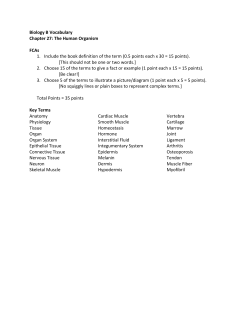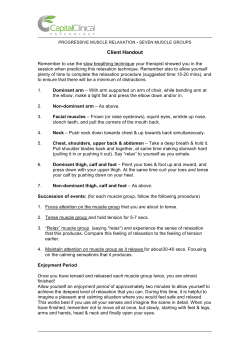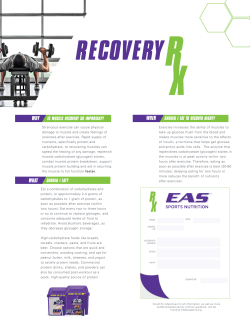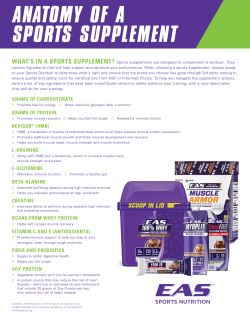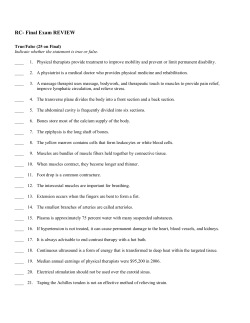
Noodle TONE UP IAFC 2015-âPedro Santos I
382 – Noodle TONE UP IAFC 2015-‐Pedro Santos Important Questions • What are the characteristics of the material? • The equipment / material is the most suitable for the population? • For what purpose you will use the equipment in a particular class or exercise? • The equipment will help to achieve these objectives? • This material meets the specific objectives of the lesson? Main objectives of the use of materials • Increase the variety, diversity of classes • Increase or decrease the intensity of exercise • Support / floating the years and the population • Provide participants with the chance to progress in the exercises Flotation Equipment (characteristics) • Dense material like foam floating on water • Able to create great resistance in the water • Interacts with the buoyancy forces • Allows a body stay on the surface • Characteristics of the Flotation The vector of buoyancy (vertical and low direction up) acts of the pool to the surface background. • Any movement towards to the ground of pool using a flotation device is resisted and is usually a concentric muscle work. This type of exercise goes against the natural tendency of the material to keep the surface. • Any movement realized from the ground of pool to top will be assisted by the flotation and is usually represented by an eccentric muscle work. The muscle has to generate force while extends to control the upward movement towards the surface, this movement facilitated by the material used. Considerations about the resistance of exercise • Lever arm length • Surface area of the object • Floating object • Speed of execution Same exercise ≠ intensities ≠ people (Length of the limbs; range of movement; execution speed) How To Use? Major Common Errors Speed: • Using movements that are too quick to run safely • Rely solely on speed to change the intensity • Increase the speed when working with large amplitudes or levers • Forget progressions and transitions safe and effective • Always employ the same execution speed Muscular balance: mundohidro_pedrito@hotmail.com • Use the same muscle groups repeatedly. Improper formatting of the training program Do not work the muscle pair • Alignment: • Allow wrong techniques • Neglecting postural correction • Change constantly exercise, before the students get back to the base of the intended movement position • Not take into account the body density of each student Posture/Statements: • Some strong statements, giving an unfaithful image of what is intended • Allow hyperextension of the joints • Rely exclusively on physical demonstration • Adopt awkward postures Planning: • Spend years without ever having experienced the • Do not train in the water • "Invent" exercises, but not "invent" learning thereof • Always use the same type of class, movements, amplitude, angles, materials, FB's, music… • Do not adapt the exercises to different types of students • Constantly use the same kind of takes your dumbbells • Neglecting the teaching of the input and output of water to the materials, as well as their placement and maintenance Format Classes • Aerobic -‐ Choreographed -‐ Freestyle -‐ Mixed • Strength resistance • Interval • Circuit How To Analyze? Main Movements & Muscles Muscle Name Location Articulation Movement Prior to neck Intervertebral Flexion and Sternocleidomastoid Cervical Pectoral Chess, Shoulder Sternoclavicular Trapezius superior, medial and inferior. Upper back Sternoclavicular Scapula (cervical mundohidro_pedrito@hotmail.com rotation of the head Horizontal adduction and flexion of the arm Elevation, retraction and intervertebral) depression of the scapula Latissimus dorsi Medial and bottom of the back Shoulder Adduction and extension of the shoulder Deltoid anterior, middle and posterior Over the Shoulder Shoulder Biceps Prior to upper arm Posterior to the upper arm Anterior part of the forearm Back of the arm Elbow, shoulder Elbow, shoulder Wrist Flexion, abduction and extension of shoulder Elbow flexion, arm flexion Elbow extension, arm extension Wrist flexion Wrist Wrist extension Triceps Wrist flexion Wrist extension Fundamental concepts of Biomechanics? 1. Plans and Disclosure Movement Axles • Sagittal Plane Takes up front to back, or vice versa, and bisects the body into two parts/halves, right and left. It is considered as a vertical plane and the movements that are observed are the flexion and extension. • Transverse Axis This is perpendicular to the sagittal plane, directs from right to left or vice versa, and passes through the joint allowing movement. • Frontal Plane Directs from right to left or vice versa and bisects the body in front and rear halves. It is considered as a vertical plane and the movements that are associated are the adduction, abduction and lateral flexion of the trunk. • Sagittal Axis This is perpendicular to the frontal plane, directs it back to the front or vice versa and passes through the joint allowing movement. • Cross Plane It is considered as a horizontal plane that divides the body into two parts, upper and lower. The movements that are associated are the pronation, supination, eversion, inversion and rotation of the trunk • Longitudinal Axis This is perpendicular to the transverse plane, directs from top to bottom or vice versa, and passes through the joint allowing movement. 2. Intramuscular Coordination Agonist: first to move or major muscle responsible for the movement. The muscle that is active in contracting. Antagonist: The muscle that opposes the agonist. It muscle contraction, which tends to produce a joint exactly the opposite action to the action of other specific muscle. Often relaxes to allow the agonist to contract mundohidro_pedrito@hotmail.com Terminology Isometric contraction: characterized by being performed without any change in muscle length, since the resistance is equal to the maximum force that the muscle can generate. Isotonic contraction: means equal voltage or constant, and is characterized by no change in maximum muscle tension. It is also referred to as dynamic, because there is change in length during their action. 3. Types of muscle contraction • Isometric Contraction An action is isometric when one muscle tension and for which no change occurs in muscle length. The force exerted is equal to the resistance. Depending on the relationship between muscle strength and resistance to be overcome can be grouped into concentric (positive) or eccentric (negative). • Concentric: when there sarcomere shortening due to the agonist muscle force is greater than the resistance. • Eccentric: if the force generated by muscles is less than the resistance of this type will be characterized by increased contraction of the sarcomere length during contraction. The eccentric contraction is not the passive phase of a concentric contraction. • Concentric Contraction When an action is concentric muscle tension resulting in muscle shortening, i.e. there is an approximation of the bones in which they are inserted. The force exerted is greater than the resistance. • Contraction Eccentric An eccentric action when there is the development of muscular tension which promotes muscle stretching, and the bones, which are inserted, deviate. The exerted force is less than the resistance. Exercise Natural Land Submerged Movement Movement Movement Curl the Biceps Forearm flexion Biceps brachial Biceps concentric Biceps concentric Forearm Triceps brachial Biceps eccentric Biceps concentric Table of extension muscle Curl I .M. actions to Bending t he l eg Hamstring Hamstring Hamstring natural concentric concentric movements, Quadriceps Hamstring Quadriceps on land and Leg extension eccentric concentric submerged Side Arm Movement Arm abduction Adduction of the Deltoid Latissimus dorsi Deltoid concentric Deltoid eccentric mundohidro_pedrito@hotmail.com Deltoid concentric Latissimus dorsi arm Side of I.M. Movement Abduction of the leg Adduction of the leg Arm Front Elevation Flexion Extension Abductor Abductor concentric Abductor Abductor eccentric Deltoid, pectoral Deltoid, pectoral and brachial and brachial biceps biceps concentric Deltoid, Deltoid, pectoral latissimus dorsi and brachial and triceps biceps eccentric Concentric Abductor concentric Abductor concentric Deltoid, pectoral and brachial biceps concentric Deltoid, pectoral and brachial biceps concentric Exercises Curl the Biceps Table muscle actions for Floating material Forearm flexion Forearm extension Curl I.M. Bending the leg Leg extension Side Arm Movement Arm abduction Adduction of the arm Side of I.M. Movement Abduction of the leg Adduction of the leg Arm Front Elevation Flexion Extension Flotation Eccentric brachial Triceps Concentric brachial Triceps Quadriceps eccentric Quadriceps concentric Great eccentric dorsal Great concentric dorsal Adductor eccentric Adductor concentric Deltoid, latissimus dorsi and eccentric triceps Deltoid, latissimus dorsi and concentric triceps mundohidro_pedrito@hotmail.com
© Copyright 2025
